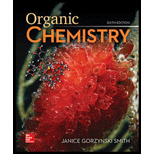
ORGANIC CHEMISTRY (LOOSELEAF)
6th Edition
ISBN: 9781260475630
Author: SMITH
Publisher: MCG
expand_more
expand_more
format_list_bulleted
Question
Chapter 25, Problem 41P
Interpretation Introduction
Interpretation: The preparation of X from a constitutional isomer by a series of
Concept introduction: Curved arrows aid in determining the movement and flow of electrons in the reaction. The electrons that take part in the
Electrocyclic reactions involve the conversion of
Expert Solution & Answer
Want to see the full answer?
Check out a sample textbook solution
Students have asked these similar questions
Provide the reasonable steps to achieve the following synthesis.
Identify which compound is more acidic. Justify your choice.
Provide the reasonable steps to achieve the following synthesis.
Chapter 25 Solutions
ORGANIC CHEMISTRY (LOOSELEAF)
Ch. 25.1 - Prob. 1PCh. 25.2 - Problem 27.2
For each molecular orbital in Figure...Ch. 25.2 - Problem 27.3
(a) Using Figure 27.2 as a guide,...Ch. 25.3 - Prob. 4PCh. 25.3 - Prob. 5PCh. 25.3 - Prob. 6PCh. 25.3 - Prob. 7PCh. 25.3 - Prob. 8PCh. 25.3 - Prob. 9PCh. 25.3 - Problem 27.11
What product would be formed by the...
Ch. 25.4 - Consider cycloheptatrienone and ethylene, and draw...Ch. 25.4 - Problem 27.13
Show that a thermal suprafacial...Ch. 25.4 - Prob. 13PCh. 25.5 - Prob. 17PCh. 25.5 - Prob. 18PCh. 25.5 - Prob. 19PCh. 25.5 - Prob. 20PCh. 25.5 - Prob. 21PCh. 25.5 - Prob. 22PCh. 25.5 - Problem 27.25
(a) What product is formed by the...Ch. 25.6 - Prob. 24PCh. 25 - Prob. 25PCh. 25 - Prob. 26PCh. 25 - Prob. 31PCh. 25 - Prob. 32PCh. 25 - Prob. 33PCh. 25 - Prob. 34PCh. 25 - Prob. 35PCh. 25 - Prob. 36PCh. 25 - Prob. 37PCh. 25 - Prob. 41PCh. 25 - Prob. 42PCh. 25 - Prob. 44PCh. 25 - Prob. 45PCh. 25 - 27.47 What product is formed from the [5,5]...Ch. 25 - 27.52 Draw the products of each reaction.
c....
Knowledge Booster
Similar questions
- When anisole is treated with excess bromine, the reaction gives a product which shows two singlets in 1H NMR. Draw the product.arrow_forward(ii) Draw a reasonable mechanism for the following reaction: CI NaOH heat OH (hint: SNAr Reaction) :arrow_forwardDraw the major product in each of the following reaction:arrow_forward
- Draw the mechanism for the following Friedel-Craft reaction. AlBr3 Brarrow_forward(a) Draw the structures of A and B in the following reaction. (i) NaNH2, NH3(1) A + B (ii) H3O+arrow_forwardFor the reaction 2 N2O5(g) → 4 NO2(g) + O2(g), the following mechanism has been proposed: N2O5 →> NO₂+ NO3_(K1) NO2 + NO3 → N2O5 (k-1) NO2 + NO3 → → NO2 + O2 + NO (K2) NO + N2O5- NO2 + NO2 + NO2 (K3) d[N₂O5] __2k‚k₂[N2O5] Indicate whether the following rate expression is acceptable: dt k₁₁+ k₂arrow_forward
- Consider the following decomposition reaction of N2O5(g): For the reaction 2 N2O5(g) → 4 NO2(g) + O2(g), the following mechanism has been proposed: N2O5 → NO2 + NO3 (K1) NO2 + NO3 → N2O5 (k-1) NO2 + NO3 → NO2 + O2 + NO (K2) NO + N2O5 → NO2 + NO2 + NO2 (K3) Indicate whether the following rate expression is acceptable: d[N2O5] = -k₁[N₂O₂] + K¸₁[NO₂][NO3] - K¸[NO₂]³ dtarrow_forwardIn a reaction of A + B to give C, another compound other than A, B or C may appear in the kinetic equation.arrow_forwardFor the reaction 2 N2O5(g) → 4 NO2(g) + O2(g), the following mechanism has been proposed: N2O5 →> NO₂+ NO3_(K1) NO2 + NO3 → N2O5 (k-1) NO2 + NO3 → → NO2 + O2 + NO (K2) NO + N2O5- NO2 + NO2 + NO2 (K3) d[N₂O5] __2k‚k₂[N2O5] Indicate whether the following rate expression is acceptable: dt k₁₁+ k₂arrow_forward
- Given the reaction R + Q → P, indicate the rate law with respect to R, with respect to P and with respect to P.arrow_forwardSteps and explanations. Also provide, if possible, ways to adress this kind of problems in general.arrow_forwardk₁ Given the reaction A B, indicate k-1 d[A] (A). the rate law with respect to A: (B). the rate law with respect to B: d[B] dt dtarrow_forward
arrow_back_ios
SEE MORE QUESTIONS
arrow_forward_ios
Recommended textbooks for you

 Organic ChemistryChemistryISBN:9781305580350Author:William H. Brown, Brent L. Iverson, Eric Anslyn, Christopher S. FootePublisher:Cengage Learning
Organic ChemistryChemistryISBN:9781305580350Author:William H. Brown, Brent L. Iverson, Eric Anslyn, Christopher S. FootePublisher:Cengage Learning


Organic Chemistry
Chemistry
ISBN:9781305580350
Author:William H. Brown, Brent L. Iverson, Eric Anslyn, Christopher S. Foote
Publisher:Cengage Learning